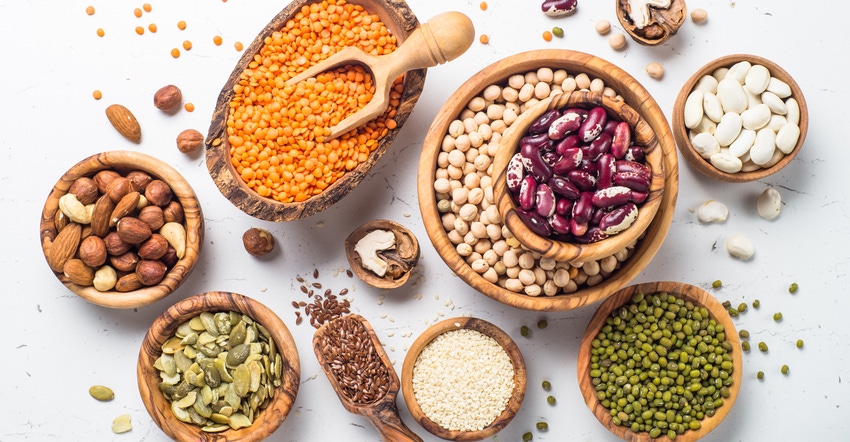As consumers move away from animal-based to plant-based proteins, the food industry is integrating its supply chains with front-end product packaging and marketing processes.
March 5, 2018

The human genome has largely stayed unchanged over the past 10,000 years when, it is believed, people started cultivating land to raise crops. Human diets and lifestyles progressively changed over these millennia, with the mismatch between the original genome, lifestyle and diet now leading to increased global epidemics of obesity, hypertension and other lifestyle diseases. Ancient diet was largely composed of lean protein (much of which was plant-based) and other nutrients obtained from nature during hunting and gathering activity (Mayo Clin Proc. 2004 Jan;79(1):101-8).
Researchers from the Massachusetts Institute of Technology (MIT), Cambridge, based on FAO/Agrostat data, computed that 65 percent of protein consumed in the world is plant-based (Am J Clin Nutr. 1994 May;59(5 Suppl):1203S-1212S). In the United States, though, greater emphasis continues to be on animal-based protein, weighing in at 70 percent of protein consumed.
Some may question whether vegans, who rely on plant-based proteins, need to be concerned about amino acid imbalances. However, the MIT review concluded plant-based proteins contain sufficient quantities of all the essential amino acids required by the body. Whole and healthy vegan sources of protein include tofu, beans, lentils, soymilk, green peas, nuts, seeds, whole grains, peanut butter, spinach, sweet corn and mushrooms.
China, United Arab Emirates and Australia are estimated to be the fastest-growing markets between 2015 and 2020 for vegan products, according to Statistica. Australia is expected to post 9.6 percent growth, and China, a growth rate of 17.2 percent. Similar growth trends are being observed in the Asia-Pacific region.
The food industry is watching these trends. Nearly all major retailers now have soy and vegetarian products on their shelves. A latte with soymilk has been standard fare at Starbucks for quite some time. Plant-based protein is in fashion, especially with Millennials.
Global Market Insights, Inc. projected the protein-ingredient market will reach US$43.3 billion by 2024. As there is increasing understanding that plant-based proteins have adequate nutritional mix to meet human requirements of protein, the shift from animal- toward plant-based protein is likely to strengthen. The firm anticipates the global plant-protein market will reach $10 billion by 2020.
The emerging plant-protein business offers great opportunities for not just the large players, but the entire food industry. While big brands will innovate products specific to a market using the most preferred plant proteins, these companies do not operate in isolation. Growers, ingredient suppliers, testing laboratories, logistics companies, supply chain technology solution providers and managers are increasingly leveraging this trend. Each geography and ecosystem has its unique sets of suppliers and providers. Many of them are captive suppliers to multinational food producers. A few startups, especially ones offering organic products, are building their own independent supply chains and marketing infrastructure.
The trend is to build an efficient farm-to-factory supply chain. This entails tying up with growers, offering agronomic technical support, lifting produce from the farm or a collection point, and transporting produce to the nearest processing unit. Ingredient suppliers and plant protein crop producers are even offering concessional credit to growers.
Depending upon regulatory requirements, food industry companies use independent product testing companies to ensure a product or ingredient conforms to a set standard. Deviations to regulatory standards can be costly to the industry, and exercising extreme caution is critical.
The commodities market is cyclical in nature. With the exception of those being cultivated in controlled environments, crops are dependent on nature—and, therefore, are vulnerable to pests and diseases. Most efficient ingredient suppliers offer price-protection guarantees to growers. A price-support mechanism that offers the grower a standard uniform price helps override a boom-and-bust production cycle. This price protection is regarded as a major incentive by growers.
To leverage the emerging plant protein growth market, the food industry ecosystem is building a streamlined sourcing and supply chain system that is increasingly integrated with front-end product packaging and marketing processes. This trend is taking place in many parts of the world, and is likely to strengthen with demand. The plant protein market is in for a sustained bull run.
Sudhir Ahluwalia (sudhirahluwalia.com) is a business consultant. He has been management consulting head of Tata Consultancy Services, an IT outsourcing company in Asia, business advisor to multiple companies, columnist and author of the book “Holy Herbs.” Ahluwalia was also a member of the Indian Forest Service.
About the Author(s)
You May Also Like




.png?width=800&auto=webp&quality=80&disable=upscale)